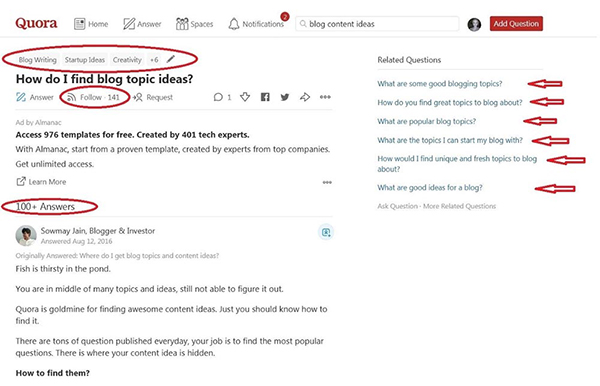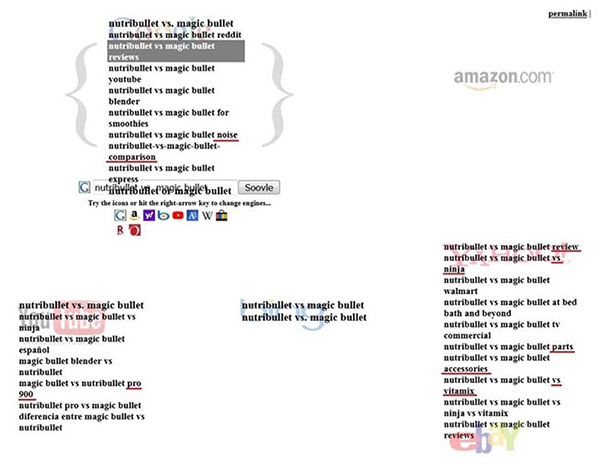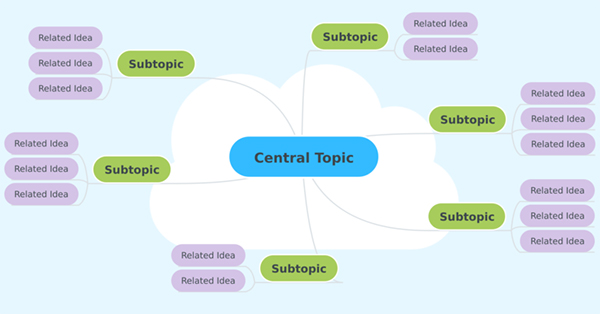Home » Content Marketing » Writer’s Block? Try These 6 Savvy Strategies to Get Quick Content Ideas Today

Writer’s Block? Try These 6 Savvy Strategies to Get Quick Content Ideas Today
Need some fresh content ideas today? What if you could have a set of strategies that work every time? This would save your neck whenever you’re scraping together for blog topic ideas at crunch time.
Retaining a creative spark isn’t easy when you need to keep the ideas coming. And yet, you need consistency. It’s the only infallible way to rise above the digital noise.
In a world where 2.5 million blog posts are published every day, consistency in blogging is a must. It adds authority to your blog, boosts your SERP rankings and helps establish your brand.
So next time you can’t think of anything new for your blog, try these 6 savvy strategies to get quick content ideas.
1: Use All the Resources At Hand
Since blogging is a matter of consistency, your resources are scarce. That’s why you should make sure to exploit any available sources for your potential blog ideas.
Remember, you want to go where your readers go and pursue sources your readers pursue. Otherwise, your audience won’t give two cents about what you write.
“It’s important to follow the news, issues, trends and research that affect your industry or niche. Such information undoubtedly affects your audience, their business, as well as your own business.”
Source: Content Marketing Institute
You won’t achieve gains in organic sales from Google until you start writing content that resonates with your readers.
Address those issues that affect your audience and you’re on the right track.
But, where to find your content ideas? Here are a few go-to sources:
- Do topic research. Allow the information to sink in. Then take notes as you enter the second round of research. It’s a foolproof way to put your own twist to the story.
- Brainstorm. Ideally, step away from your workstation. Some of the best ideas are born offline. Use post-its and color markers to make things easier to track.
- Use Google Alerts. Head over to Google Alerts to fetch new publications related to your industry niche.
- Read industry blogs. Read any materials you can lay your hands on that’s coming from authority sources in your niche. Use Evernote or Pocket to organize your reading list.
- Listen to top podcasts. Again, aim for the industry gurus. But also, stretch into the more general territory to get more ideas for your content. For example, Akimbo podcast by Seth Godin will give you a fresh take on cultural matters. This is a great way to get input from thought leaders.
2: Use Quora to Find Blog Topic Ideas
You can also rely on Quora to help you with your content planning. It’s a goldmine of reader-specific information. A Q&A website that features user-generated content on popular and less popular topics.
You can expect encouraging content marketing results only if you provide relevant content. Once you know what that is you need to keep doing it.
This is where you can begin to see a snowball effect with your content strategy. Especially because writing “People also ask” articles has a joined SEO effect as well.
So, use Quora to look up some common questions your target audience is asking. Then create data-driven copy that answers those questions. Easy.
Pro Tip: Want to find only the most relevant and most popular topics on Quora? Do a little bit of question analysis.
Here’s how you do it.

Screenshot source Quora
Search for your target keyword in Quora. Then choose a question and quickly analyze the page.
What you’ll see is:
- The related keywords section
- The number of followers and answers
- Related questions on the right side of the page
These parameters will show whether the topic is relevant to your audience and to what degree. If you decide the question is not up to the mark, repeat this test with other related questions.
But let’s look at the Question Stats now.

Screenshot source Quora
Here’s where you look at the ratio of views versus followers. This ratio will tell you which questions are in the highest demand.
The “Last Followed data” will tell you whether a question is still sought after by your audience. In other words, whether it’s worthwhile to pick it up as your blog topic or not.
You can also earn yourself a quality backlink if you answer a question in Quora and then link out to your blog post.
3: Talk About Creative Ways Your Product Can Be Used
After you’ve written 100+ articles on topics that relate to your product or service, you’ll want to call it quits. Let’s take a real estate blog as an example. You can’t keep writing about “why real estate is the best investment” for days on end, right?
So, here’s what you can do to spice it up a bit.
Try to find a unique take on the product you’re selling. It can be a fun or unconventional way to use it.
Let’s say you’re selling Android phones. You can write about alternative uses of discarded phones, for example. Any tech geek would love to learn they can use their outdated gadget as a baby monitor or a video doorbell.
Similarly, if you’re selling boxed cake you can collate a list of fun delicacies that can be made using the product.
4: Give Your Readers What They Want
Keyword research is a content marketer’s staple. You can use it to:
- Build your content marketing strategy from scratch,
- Analyze your competitors, and
- Come up with your content creation ideas.
For the purpose of this article, we’ll stick to the last use of it – content ideation.
Let’s say you’re running a tech blog and one of your topics is kitchen appliances. Your target audience will likely want to read product reviews and comparison articles.
But, how do you figure out which topics are trending?
Let’s head over to Ubbersugest to find out. Pick any two similar products on your category pages and enter the keyword into Ubersuggest.
For example, nutribullet vs. magic bullet.

Screenshot source Neilpatel
You can immediately get an idea about what answers people are seeking.
But to get even more details, type your keyword into the Soovle Keyword Tool.

Screenshot source Soovle
There are a few categories the tool brings to your attention. Once you identify them, you can create content pieces that address those issues.
In our example, here are some issues consumers are interested in:
- Comparison. Many consumers are unsure which blender is best in the market. It’s possible they don’t know much beyond the names of the products. They use modifiers such as comparison, reviews, and different product names to narrow down their search.
- Product accessories. People are also interested in finding out about different blender parts and functionalities.
- Noise. A relevant factor in the buying decision is the level of noise different types of blenders make.
With this in mind, you can decide to create a cluster of blog ideas around this topic, knowing your audience will be eager to read it.
And this means more search engine traffic for you!
5: Use the Lateral Thinking Strategy
When we get stuck, it often happens because we treat our topic in a straightforward fashion. A slight change of approach is where the magic happens (and where your creative anguish ends).
Lateral thinking involves approaching a problem in an indirect, creative way. It’s looking for less conspicuous links between different concepts that tie in together.
This method can give you a plethora of tangential content ideas that are fun to read. And yes, even if you’re writing on a topic of toilet fixtures.
So, instead of writing another article about how to keep toilets clean, try exploring some ideas that don’t immediately pop to mind, but are still (at least remotely connected to your topic).
Here are some possible content ideas you can explore.
- Start with how-to articles that address immediate pain points of your audience. You can go from ‘how to remove vinegar stains from tiles’ to ‘how to choose low-maintenance fixtures’.
- Next, you can explore the history of marble and dedicate an article to its use in ancient Roman and Greek times. Or you can create a bubble chart that represents the history of porcelain trade on a timeline.
- Then you can add an even more unconventional twist to the topic. You can draw inspiration from movie trivia involving toilet scenes. Or you can talk about the first movie that featured toilet flushing, etc, etc.
And then there’s design. Your options are endless here. Your blog can feature a list of DIY bathroom ideas. Or it can talk on topics aimed at different audiences, from eco to price-conscious to upscale consumers.

Image source Mindmeister
Over to You
Anyone who’s ever had to churn out content ideas knows how arduous this process can be. And while your content calendar can’t wait, your brain will sometimes refuse to cooperate.
Use the 6 savvy strategies above to get quick content ideas when you need them most. Tread the path many marketers have trodden as they strive to achieve their content marketing goals.
Once you choose the right trajectory for growing your brand, the desired results will follow.
CopySmiths
I'm Katrina McKinnon, founder of CopySmiths and Small Revolution. In my 20 years of experience, I have helped online businesses create high-performing content specifically on an eCommerce store's blog. Find me on LinkedIn and Twitter.

CopySmiths offers the best blog writing services for online stores.
If you'd like us to write blog articles for you, click here.
Most Recent
- 3 Bold Questions You Should Ask When Hiring A Content Writer

- 5 Practical Reasons You Should Use a Blog Post Template

- 4 Amazing Benefits of Using a Title Generator for New eCommerce Blogs

- 10 Awesome Bio Examples Your Online Store Blog Should Emulate

- 8 Basic Steps to Successful Content Development Every Time

Podcasts
Got a question?
Ask our friendly team about our article writing services.
Subscribe to CopyZine
Monthly, hand-picked stories of the best in eCommerce Content.




